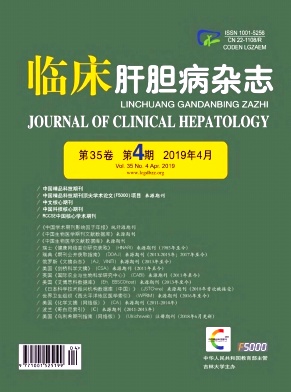|
[1]LI XC, WANG HW, LI CX.Present situation and prospect of comprehensive treatment of hepatocellular carcinoma[J].Chin J Dig Surg, 2018, 17 (5) :433-436. (in Chinese) 李相成, 王宏伟, 李长贤.肝癌综合治疗的现状与展望[J].中华消化外科杂志, 2018, 17 (5) :433-436.
|
|
[2]CHEN Y, ZHOU J, FAN J, et al.Clinical effect and prognostic factors analysis of intraoperative radiofrequency ablation in treatment of hepatocellular carcinoma with severe cirrhosis[J].Chin J Dig Surg, 2017, 16 (2) :159-163. (in Chinese) 陈漪, 周俭, 樊嘉, 等.术中射频消融治疗合并重度肝硬化肝细胞癌的临床疗效及预后因素分析[J].中华消化外科杂志, 2017, 16 (2) :159-163.
|
|
[3]LLOVET JM, VLIANA R, BRU C, et al.Increased risk of tumor seeding after percutaneous radiofrequency ablation for single hepatocelhlar carcinoma[J].Hepatology, 2001, 33 (5) :1124-1129.
|
|
[4]MULIER S, MULIER P, NI Y, et al.Complications of radiofrequency coagulation of liver tumours[J].Br J Surg, 2002, 89 (10) :1206-1222.
|
|
[5] RHIM H, YOON KH, LEE JM, et al.Major complications after Radio-frequency thermal ablation of hepatic tumors:Spectrum of imaging findings[J].Radio Graphics, 2003, 23 (1) :123-136.
|
|
[6]CHANG S, KIM SH, LIM HK, et al.Needle tract implantation after percutaneous interventional procedures in hepatocellular carcinomas:Lessons learned from a 10-year experience[J].Korean J Radiol, 2008, 9 (3) :268-274.
|
|
[7]CHANG S, KIM SH, LIM HK, et al.Needle tract implantation after sonographically guided percutaneous biopsy of hepatocellular carcinoma:Evaluation doubling time, frequency, and features on CT[J].AJR Am J Roentgenol, 2005, 185 (2) :400-405.
|
|
[8]KIM SH, LIM HK, LEE WJ, et al.Needle-tract implantation in hepatocellular carcinoma:Frequency and CT findings after biopsy with a 19.5-gauge automated biopsy gun[J].Abdom Imaging, 2000, 25 (3) :246-250.
|
|
[9]ISHII H, OKADA S, OKUSAKA T, et al.Needle tract implantation of hepatocellular carcinoma after percutaneous ethanol injection[J].Cancer, 1998, 82 (9) :1638-1642.
|
|
[10]ZHANG DK, JI JS, TU JF, et al.A discussion of reasons and methods of prevention and cure for serious complications of radiofrequency ablations in the treatments of hepatocellular carcinomas[J].Chin J Radiol, 2016, 50 (3) :213-216. (in Chinese) 张登科, 纪建松, 涂建飞, 等.射频消融治疗肝癌严重并发症原因分析及其防治方法探讨[J].中华放射学杂志, 2016, 50 (3) :213-216.
|
|
[11]TARANTINO L, FRANCICA G, ESPOSITO F, et al.Seeding from hepatocellular carcinoma after percutaneous ablation:Color Doppler ultrasound findings[J].Abdom Imaging, 2006, 31 (1) :69-77.
|
|
[12]ARRIVE L, VURGAIT A, MONNIER-CHOLLEY L, et al.Long-term follow-up after neoplastic seeding complicating percutaneous ethanol injection for treatment of hepatocellular carcinoma[J].Eur Radiol, 2002, 12 (1) :74-76.
|
|
[13]TAKEMURA N, HASEGAWA K, AOKI T, et al.Surgical resection of peritoneal or thoracoabdominal wall implants from hepatocellular carcinoma[J].Br J Surg, 2014, 101 (8) :1017-1022.
|
|
[14]STIGLIANO R, BURROUGHS AK.Should we biopsy each liver mass suspicious for HCC before liver transplantation?-no, please don’t[J].J Hepatol, 2005, 43 (4) :563-568.
|
|
[15]WU XY, ZHOU JX, ZHOU T, et al.Diagnosis and treatment of neoplastic needle tract seeding following radiofrequency ablation of primary hepatic carcinoma[J].J Hepatobiliary Surg, 2011, 19 (6) :420-422. (in Chinese) 吴星宇, 周建新, 周铁, 等.原发性肝癌冷循环射频治疗术后针道种植转移的诊断与治疗[J].肝胆外科杂志, 2011, 19 (6) :420-422.
|
|
[16]NAKAMURA M, HAYAMI S, UENO M, et al.Detection of needle tract implantation and peritoneal seeding after radiofrequency ablation using intraoperative near-infrared fluorescence system for recurrent hepatocellular carcinoma:A case report[J].Surg Case Rep, 2018, 4 (1) :76.
|
|
[17]SIDANA A, CHOWDHURY WH, FUCHS EJ, et al.Cryoimmunotherapy in urologic oncology[J].Urology, 2010, 75 (5) :1009-1014.
|
|
[18]National Health and Family Planning Commission of the People’s Republic of China.Diagnosis, management, and treatment of hepatocellular carcinoma (V2017) [J].J Clin Heptol, 2017, 33 (8) :1419-1431. (in Chinese) 中华人民共和国国家卫生和计划生育委员会.原发性肝癌诊疗规范 (2017年版) [J].临床肝胆病杂志, 2017, 33 (8) :1419-1431.
|
|
[19]MCDEVITT JL, MOULI SK, NEMCEK AA, et al.Percutaneous cryoablation for the treatment of primary and metastatic lung tumors:Identification of risk factors for recurrence and major complications[J].J Vasc Interv Radiol, 2016, 27 (9) :1371-1379.
|
|
[20]AOUN HD, LITTRUP PJ, JABER M, et al.Percutaneous cryoablation of renal tumors:Is it time for a new paradigm shift?[J].J Vasc Interv Radiol, 2017, 28 (10) :1363-1370.
|
|
[21]JIANG K, TANG K, GUO X, et al.Laparoscopic cryoablation vs.percutaneous cryoablation for treatment of small renal masses:A systematic review and meta-analysis[J].Oncotarget, 2017, 8 (16) :27635-27644.
|
|
[22] NIU LZ, HE LH, ZHOU L, et al.Percutaneous cryoablation and125I seed implantation combined with chemotherapy for advanced pancreatic cancer:Report of 67 cases[J].Chin JOncol, 2012, 34 (12) :940-944. (in Chinese) 牛立志, 何丽华, 周亮, 等.经皮冷消融与125I粒子植入联合化疗治67例晚期胰腺癌的疗效和安全性[J].中华肿瘤杂志, 2012, 34 (12) :940-944.
|







 DownLoad:
DownLoad: